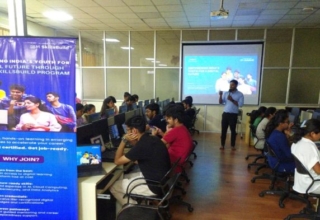
India’s design education holds immense promise for the future. By embracing continuous improvement, fostering strong industry linkages, and nurturing a future generation of design pioneers, India’s design schools can ensure that the nation thrives not just as a design powerhouse but as a global leader in innovation for years to come says Thomas Dal, Dean of Strate School of Design, Bangalore
 In our rapidly evolving world, design education is no longer a mere aesthetic pursuit. Design education extends beyond product embellishment. It equips students with a powerful toolkit: creative problem-solving, analytical skills, and a deep focus on user-centricity. This empowers them to tackle complex societal challenges with innovative solutions.
In our rapidly evolving world, design education is no longer a mere aesthetic pursuit. Design education extends beyond product embellishment. It equips students with a powerful toolkit: creative problem-solving, analytical skills, and a deep focus on user-centricity. This empowers them to tackle complex societal challenges with innovative solutions.
Furthermore, design education fosters entrepreneurship, equipping students to identify opportunities, prototype solutions, and refine them based on user feedback. This entrepreneurial spirit is vital for a thriving design-centric economy, where ingenious solutions translate into economic prosperity.
Design Education is a powerful driver of economic growth and innovation, especially for emerging economies like India. A 2023 McKinsey Global Institute report highlights this, projecting that design-thinking approaches could unlock up to $3 trillion in new value for businesses worldwide. As India strives to be a global leader, design schools play a crucial role in shaping students into dynamic agents of change. The economic benefits of a robust design sector are undeniable. The Indian design industry is poised to become a ₹1.5 lakh crore (US$21 billion) giant by 2024, driven by the rising demand for skilled designers across diverse sectors like product design, UX, communication design, and sustainable infrastructure.
Success stories abound, highlighting the transformative power of design education. Graduates from prestigious Indian institutions have established innovative startups like The Better India, a social enterprise driving change in rural India. These narratives showcase the profound impact of design thinking on overcoming real-world challenges and catalysing positive social transformation.
Current Trends
Leading design institutes in India are actively revamping their approaches to harness design education’s transformative potential. One key area is integrating social impact design principles into the curriculum. Courses like “Design for Sustainability” and “Design for Development” empower a generation of designers to not only solve problems but also drive meaningful social change.
Additionally, design schools are champions of frugal innovation, an Indian approach born from resource constraints. By equipping students with this valuable skillset, these institutions are creating designers highly sought-after by global companies for their expertise in crafting efficient and cost-effective solutions. ALSTOM, a transportation multinational, actively recruits skilled designers from India to spearhead the development of economical transportation solutions, exemplifying this trend.
In addition to promoting frugal innovation, design institutions are diligently integrating the latest design technologies into their curricula. Courses in 3D printing, user experience (UX) design, and design thinking augmented by artificial intelligence (AI) are becoming commonplace, empowering students to experiment with cutting-edge tools and create innovative design solutions. Designed to equip students with proficiency in human-computer interaction and emerging technologies like virtual reality (VR) and augmented reality (AR), the STRATE School of Design exemplifies this with its specialised programme in Interaction Design.
Overcoming Challenges
Outdated curricula, limited industry collaboration, and a lack of digital design skills among graduates can hinder the effectiveness of some design programs. The industry’s evolving demands may outpace outdated curricula, potentially hindering students’ ability to acquire cutting-edge skills. Additionally, the disconnect between academia and industry can result in a gap between the skills students develop and those required in real-world design practice. Strengthening partnerships with industry stakeholders, implementing internships, and hosting guest lectures from experienced professionals can bridge this divide and provide valuable industry insights.
Another significant challenge is the digital design skills gap. Proficiency in graphic design software, UX/UI design, and digital prototyping is crucial for design professionals. Ensuring adequate training in these digital skills is essential for graduates’ competitiveness and industry preparedness.
Opportunities
Despite these challenges, the landscape is brimming with opportunities. Institutions are actively bridging the gap between academia and industry through internships, workshops, and guest lectures from design luminaries, equipping students with real-world insights and tailoring curricula to industry needs.
In the Indian context, empowering students directly translates to fostering innovation. By fostering a design-thinking approach, design education empowers students to tackle problems creatively, fostering a culture of ingenuity across diverse sectors. The emphasis on prototyping and user-centricity creates fertile ground for design-led entrepreneurship, where graduates build pioneering startups catering to unmet market needs.
India’s design schools shape not only designers but also global innovators. By equipping students with the art of frugal innovation, these institutions are carving a niche for Indian design graduates as torchbearers of global innovation. Looking ahead, the trajectory of design education in India appears promising. As design becomes ubiquitous across industries, there will be a growing demand for interdisciplinary programmes that seamlessly integrate design thinking with engineering, technology, and business acumen.
International collaborations
Collaborations with international design institutions hold immense potential to enrich the pedagogical landscape and expose students to diverse design paradigms. Policymakers, educators, and industry stakeholders must work together to build a robust design ecosystem that empowers students to architect India’s future. Innovative design solutions that address pressing societal challenges, leverage frugal innovation, and integrate cutting-edge technologies can enable Indian design graduates to emerge as vanguards of economic growth, catapulting India to the zenith of global innovation.
Design education in India is undergoing a transformative metamorphosis, shaping students into not just adept designers but also trailblazing innovators and agents of change. Through a steadfast commitment to social impact design, the integration of design technologies, and the cultivation of a culture steeped in design-led entrepreneurship, design institutions are indelibly etching India’s imprint on the global innovation canvas.









